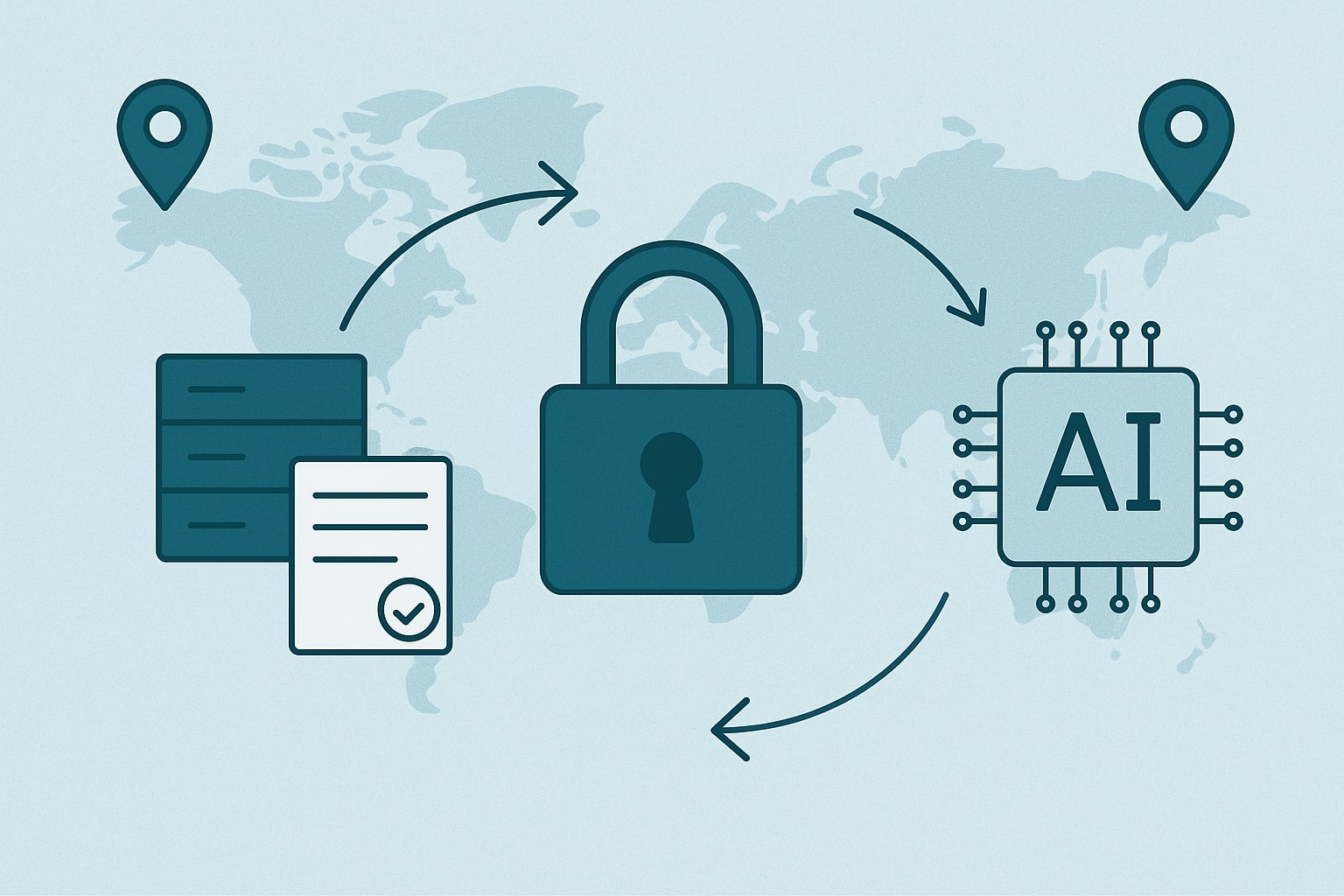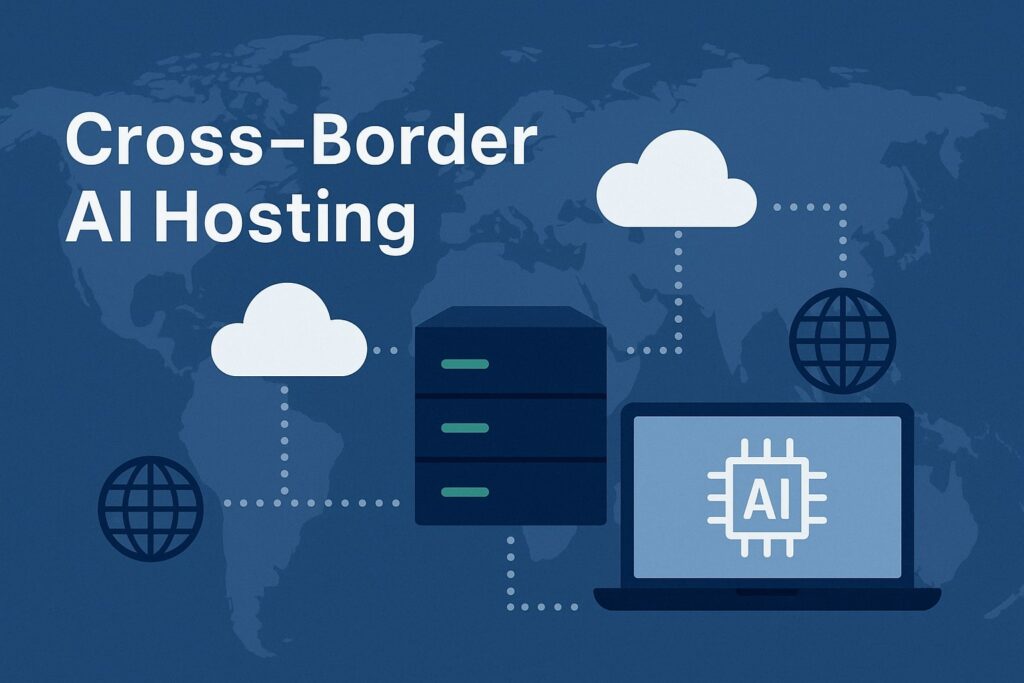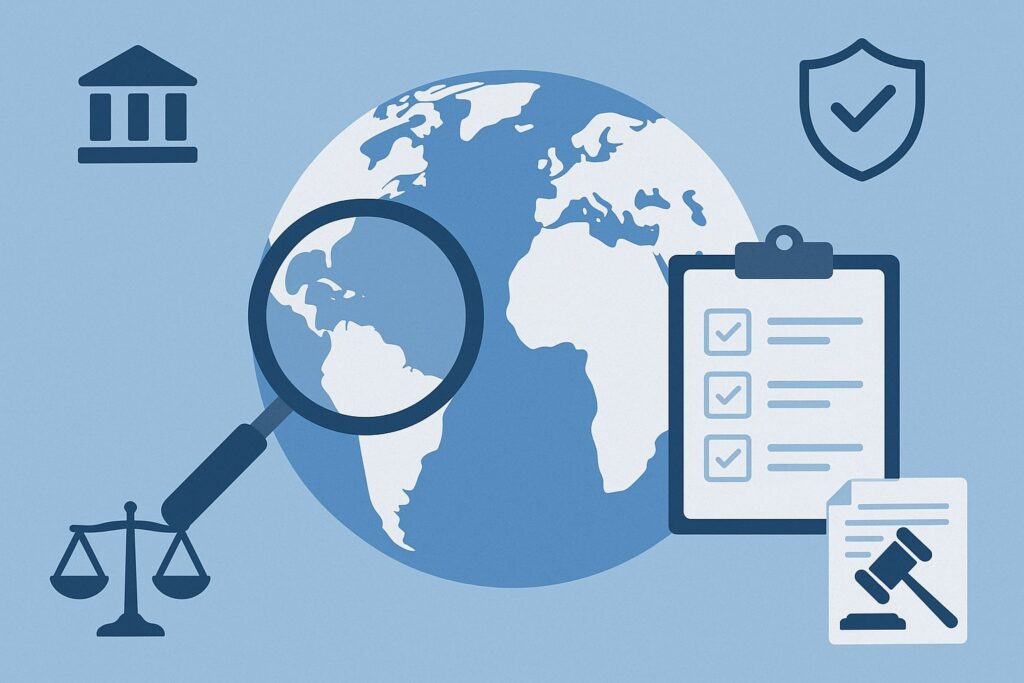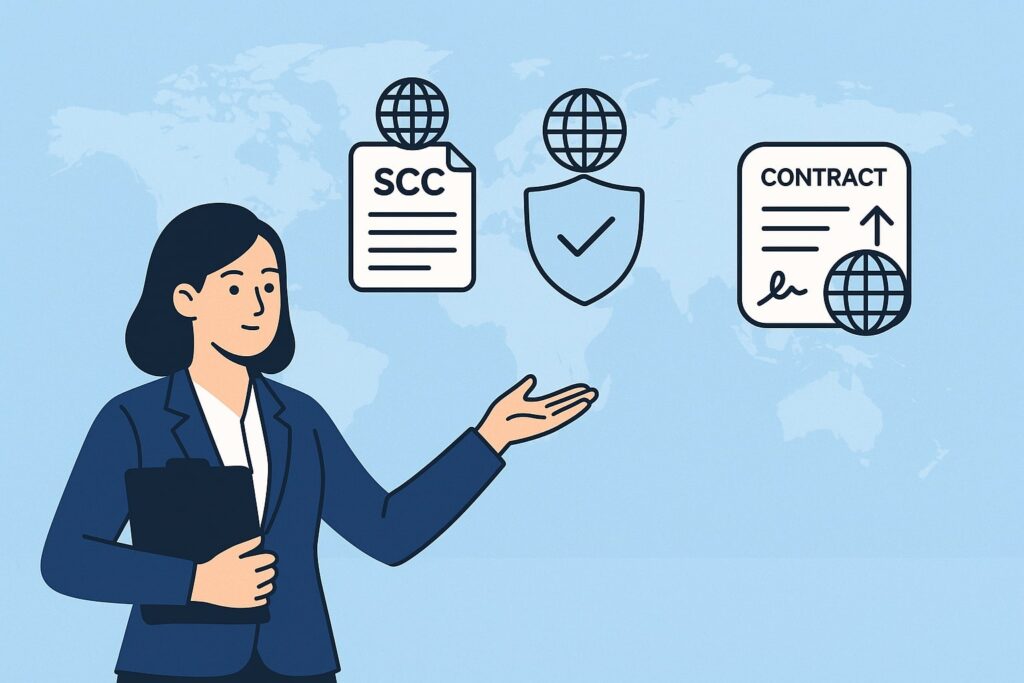
By hostmyai October 14, 2025
Modern AI lives in many places at once. Models train in one region, infer in another, and log telemetry to a third. That makes cross-border AI hosting both a superpower and a regulatory minefield.
This guide explains how to build, run, and scale AI across jurisdictions while respecting privacy, security, and sector rules. You’ll learn the practical mechanics: mapping data flows, choosing transfer mechanisms, designing region-aware architectures, and proving compliance.
We also cover fast-moving frameworks such as the EU AI Act, GDPR-based transfers, Brazil’s LGPD, India’s DPDP Act, and China’s PIPL.
Throughout, we’ll anchor recommendations to controls you can implement today—data minimization, encryption, key management, model governance, and auditability—so your cross-border AI hosting is resilient, explainable, and regulator-ready.
What “Cross-Border AI Hosting” Actually Means (and Why It’s Different)

Cross-border AI hosting is more than placing virtual machines in multiple regions. It’s the end-to-end lifecycle of data and models across legal borders.
Think training datasets stored in one country, feature stores cached near users worldwide, inference endpoints in latency-sensitive edges, and monitoring pipelines that centralize logs for safety analysis.
Each hop can trigger a different legal regime. That’s why cross-border AI hosting requires a dual focus: technical locality (where compute and storage live) and legal locality (which law applies, to whom, and when).
AI intensifies compliance complexity. Model weights may embed personal information; prompts may contain identifiers; outputs may qualify as profiling; and telemetry can reveal sensitive context. Even when you “anonymize,” re-identification risks remain if linking is possible.
You must assume that training data, embeddings, vector stores, and system logs are all regulated data surfaces. The safest mindset: design as if a regulator will inspect any artifact that moves across borders.
Finally, cross-border AI hosting is different because obligations vary by AI capability. Some laws focus on processing personal data (e.g., GDPR, LGPD, DPDP), while others add model-specific duties (e.g., the EU AI Act’s risk tiers, documentation, incident reporting).
A single architecture may need both privacy transfer tools (like SCCs) and AI-specific controls (like pre-deployment testing and risk management for “systemic-risk” models). Getting this right early prevents costly re-engineering later.
Global Regulatory Snapshot You Should Track in 2025–2026

EU AI Act (entered into force 2024). Obligations phase in. Guidance for models with systemic risk landed July 2025, with transparency and testing obligations starting August 2, 2025 for general-purpose models, and broader high-risk requirements applying in 2026.
Expect full effectiveness by around 2027 as chapters phase in. If your cross-border AI hosting involves EU users or EU-placed systems, start aligning with risk management, documentation, incident reporting, and cybersecurity controls now.
EU–US Data Privacy Framework (DPF). For transfers of personal data from the EU to US entities certified under DPF, adequacy allows transfers without extra safeguards. But the framework’s longevity remains debated by some DPAs and commentators.
You should treat DPF as usable—but design a fallback (e.g., SCCs + transfer impact assessments) in case legal winds shift.
Brazil LGPD—International Transfers. Resolution CD/ANPD No. 19/2024 sets detailed rules for overseas transfers, including the use of ANPD-approved SCCs.
There’s a compliance deadline of August 23, 2025. If your cross-border AI hosting touches Brazil—training, support analytics, or user telemetry—implement those clauses and map onward transfers.
India DPDP Act 2023. India has adopted a “blacklist” approach to cross-border transfers: data can flow to any country except those restricted by the government, with draft rules published in early 2025. Plan for dynamic country allowances and watch for sectoral carve-outs.
China PIPL + CAC measures. China maintains transfer pathways (security assessment, SCC filing, certification) but introduced relaxations and clarifications in 2024–2025, including exemptions for certain flows and clearer thresholds.
If your stack touches data about individuals in China, treat yourself as a “PI processor” subject to cross-border controls even if you’re overseas.
These regimes often overlap with sector rules (finance, health) and platform governance (app store, cloud marketplace). Your cross-border AI hosting strategy should assume multi-framework compliance rather than a single standard.
Data Mapping: The First Non-Negotiable Step

Before you pick a region or a clause, build a living data map. For cross-border AI hosting, that map must cover:
- Data classes: personal data, sensitive categories, pseudonymized records, usage logs, embeddings, fine-tuning sets, evaluation data, red-team prompts, and feedback.
- Actors: controller vs. processor roles; sub-processors (clouds, labeling vendors, API hosts); joint controllers for co-developed models.
- Flows: ingestion, storage, training, inference, monitoring, incident response, and deletion—per region.
- Purposes & legal bases: consent, contract, legitimate interests, or statutory obligations—per use (training vs. support vs. analytics).
- Transfer mechanisms: adequacy, SCCs, BCRs, certification (DPF, ANPD SCCs), CAC filings, or whitelist/blacklist logic.
Good maps are versioned, linked to your records of processing activities (RoPA), and tied to IaC (infrastructure as code). When a pipeline changes, the map updates.
This is critical evidence for DPIAs/TIAs, AI risk assessments, and regulator questions later. In cross-border AI hosting, a precise map is your north star for lawful basis selection, data minimization, and geo-fencing decisions.
Choosing a Lawful Cross-Border Transfer Mechanism

Your mechanism depends on origin jurisdiction, data type, and recipient status.
- EU / EEA ➜ non-EU: Prefer adequacy where available (e.g., EU–US DPF for certified US recipients). Otherwise, use SCCs plus a Transfer Impact Assessment and supplementary safeguards (strong crypto, transparency reports, narrow access).
For processors, ensure sub-processors sign equivalent terms and register in your data map. - Brazil ➜ foreign: Adopt ANPD-approved SCCs or other ANPD mechanisms by the Aug 23, 2025 deadline. Verify that your cloud and model-ops vendors accept the Brazilian clauses.
- India ➜ foreign: Apply the DPDP blacklist logic—allow unless a destination is restricted. Keep a registry of actual recipient countries and be ready to re-route traffic if a country becomes restricted.
- China ➜ foreign: Check if your volumes cross CAC thresholds; if yes, complete a security assessment or SCC filing. Track the 2024–2025 exemptions and clarifications to see if your flows qualify.
For cross-border AI hosting, remember that model weights and embeddings can count as personal data if re-identification is reasonably likely. When in doubt, include them in transfer scoping and apply the same mechanism.
Designing a Region-Aware, Privacy-Preserving AI Architecture
A compliant architecture makes legal constraints an engineering feature, not an afterthought. For cross-border AI hosting, consider:
- Regional data planes. Keep raw personal data in the origin region. Use privacy-filtered features for cross-region movement. Where possible, run training where data originates and move model artifacts instead of source data—paired with strict de-identification tests.
- Geo-fenced inference tiers. Place inference endpoints close to users to reduce latency but split stateless vs. stateful components. Stateless inference can be global; stateful logs and prompts stay local unless properly protected and transferred.
- Key management & envelope encryption. Use customer-managed keys (CMKs) per region. Store keys in HSMs in the same jurisdiction as the data. Rotate keys and isolate key custodians. For shared services, use split-key or threshold cryptography to limit unilateral access.
- Data minimization by design. Truncate prompts, hash identifiers, filter PII before logging, and enforce short retention windows with automatic deletion. This directly reduces transfer scope and risk.
- Privacy-enhancing technologies (PETs). Apply format-preserving tokenization for structured fields, differential privacy for analytics, federated learning to keep training local, and confidential computing to protect workloads when they must cross borders.
- Isolation for evaluation and red-teaming. Keep adversarial testing data separate with distinct retention and pseudonymization policies. Treat it as sensitive.
- Observability with redaction. Instrument your stack but redact PII at source. Use field-level access controls and purpose-based access to ensure debug visibility without over-collection.
This design allows your cross-border AI hosting to meet data localization expectations while preserving performance and developer velocity.
Meeting the EU AI Act While You Host Globally
The EU AI Act introduces AI-specific obligations that layer on top of GDPR. If you host or offer models used in the EU, plan for:
- Risk classification & governance. Identify whether your use is prohibited, high-risk, limited-risk, or GPAI/systemic-risk. Map obligations to controls: data governance, technical documentation, logging, transparency, human oversight, robustness, and cybersecurity.
- Technical documentation & datasets. Maintain documentation for training data provenance, data governance, and evaluation. Keep training data summaries and copyright due-diligence for GPAI transparency duties.
- Model evaluations & adversarial testing. Establish pre-deployment testing and periodic reassessments. Log serious incidents and implement post-market monitoring.
- Timelines. Prepare for GPAI transparency beginning Aug 2, 2025 and wider high-risk obligations phasing in by 2026, with complete effectiveness by 2027. Build your internal AI risk register now; it simplifies audits later.
When your cross-border AI hosting spans the EU and non-EU regions, pair AI-Act controls with lawful transfer mechanisms under GDPR (DPF, SCCs, BCRs). Treat them as separate checklists you satisfy in parallel.
Proving Lawful Transfers: TIAs, DPIAs, and Documentation That Stands Up
Regulators expect proof, not promises. For cross-border AI hosting, build a documentation pack:
- RoPA with cross-border flow entries and sub-processor inventory.
- Transfer Impact Assessment (TIA) evaluating foreign surveillance risks, access requests, and your crypto posture; keep supplementary measures listed and tested.
- Data Protection Impact Assessments (DPIAs) for high-risk processing such as large-scale profiling or sensitive data in training/inference.
- Vendor due diligence: SCCs, ANPD SCCs, CAC filings, DPF certification checks, SOC 2/ISO reports, and pen-test summaries.
- Key management runbooks: locations, rotations, and break-glass procedures.
- AI risk artifacts under the EU AI Act: model cards, evaluation reports, incident logs, and post-market monitoring plans.
Store these in a controlled, versioned repository. Link them to CI/CD so each release captures the current reality. This discipline turns audits into repeatable operations rather than one-off fire drills.
Country-Specific Considerations for Your Hosting Plan
European Union. If you touch EU personal data, GDPR governs—regardless of your company’s location. Use SCCs or DPF (when applicable) and keep data minimization front-and-center. If your AI is high-risk under the AI Act, expect documentation, testing, and incident reporting on top.
United States. There’s no federal GDPR-style law yet, but state laws (e.g., CCPA/CPRA, Colorado, Virginia) and sector rules (HIPAA, GLBA) still matter. For EU data into the US, DPF certification helps, with SCCs as a fallback.
Brazil. Adopt ANPD SCCs and update vendor contracts. Align consent and purpose-limitation with LGPD. Building Brazil-resident logging and support analytics can reduce transfer friction. Deadline: Aug 23, 2025.
India. Under DPDP, assume flows are permitted unless a blacklist says otherwise. Maintain a destination registry and be ready to re-route traffic quickly if the government updates restrictions.
China. Confirm whether your volumes or data types trigger CAC assessments or SCC filings. Track 2024–2025 relaxations/exemptions; they may simplify analytics or non-critical transfers, but you must document why an exemption applies.
Contracts, Governance, and the Human Layer
Compliance is not only technical. Your cross-border AI hosting must live inside strong governance:
- Data Processing Agreements (DPAs) and AI addenda: specify roles, transfer mechanisms, deletion SLAs, audit rights, security measures, and AI-specific duties (evaluation, incident reporting, bias testing).
- Sub-processor management: publish a list, provide change notices, and run risk reviews before onboarding new clouds or annotation vendors.
- Access governance: least privilege, JIT access, and purpose-bound roles (e.g., “debug access” separated from “training access”).
- Assurance: external audits (ISO 27001/27701), SOC 2 Type II, and targeted model governance attestations.
- Training & culture: privacy engineering, secure prompt handling, red-teaming hygiene, and incident simulation tabletop exercises—all tailored to cross-border AI hosting realities.
Good governance shortens due-diligence cycles with customers and reduces the chance a single misstep triggers a multi-jurisdiction incident.
Security Controls That Reduce Transfer Risk (and Please Regulators)
Security is your transfer multiplier: better controls, fewer questions.
- Strong crypto: TLS 1.3 in transit; AES-256 or ChaCha20-Poly1305 at rest; envelope encryption with per-region CMKs; HSM-backed key storage.
- Confidential computing: run sensitive inference/training inside TEEs so cloud operators can’t access plaintext—even across borders.
- PII redaction at source: strip or tokenize user identifiers in prompts/logs; use format-preserving tokenization for structured fields; apply differential privacy for analytics cohorts.
- Segmentation: separate networks and accounts by region and data criticality; enforce egress controls and explicit allow-lists for cross-region replication.
- Data lifecycle: short, automatic retention; immutable deletion logs; periodic verification of deletion in backups and DR replicas.
- Monitoring with purpose limits: redact PII in telemetry; gate access via approval workflows; keep tamper-evident audit trails.
These steps make cross-border AI hosting safer and easier to justify in TIAs and DPIAs.
Architecting for Latency, Cost, and Compliance: Deployment Patterns
Pattern A: Local-data / global-model. Train where the data lives, then export de-risked model artifacts to other regions. Use federated learning if you can’t export data. Works well for sensitive verticals.
Pattern B: Geo-fenced micro-stacks. Duplicate a slim stack per region: local data lake, local feature store, local inference, and regional monitoring. Centralize only aggregated, non-identifying metrics.
Pattern C: Central inference with PETs. Keep a single inference hub using confidential computing and tokenization. Only tokenized prompts cross borders; detokenization happens locally when needed.
Pattern D: Edge response, regional audit. Deploy edge inference for latency but store audit trails in the origin region. Synchronize models with signed releases; prohibit ad-hoc promotion from non-approved regions.
Pick the pattern that minimizes personal data movement while meeting performance goals. That’s the core of compliant cross-border AI hosting.
Vendor & Cloud Due Diligence Checklist (Use Before You Deploy)
When you onboard clouds, MLOps platforms, or API model providers for cross-border AI hosting, ask for:
- Regional services matrix: actual data locations, replication behavior, and DR sites.
- Sovereignty features: EU-only, Brazil-only, India-friendly options; local support hours; local key custody.
- Encryption posture: CMK support, HSM details, TEE availability, customer-held keys.
- Privacy artifacts: DPF certification (if relevant), SCC frameworks, ANPD SCC readiness, CAC filing experience.
- Logging & deletion: redaction options, configurable retention, verified deletion across backups.
- Sub-processor list: change-notice process and flow-down language in contracts.
- AI governance: model evaluation program, incident reporting promises, and alignment with EU AI Act timelines.
This diligence prevents lock-in to providers that cannot meet your regional obligations when policies tighten.
Practical Playbook: From Zero to Compliant Cross-Border AI Hosting
- Assemble a tiger team: privacy counsel, security, data platform, MLOps, and product.
- Create the data map: systems, data types, flows, regions, and purposes.
- Choose transfer paths: DPF or SCCs for EU, ANPD SCCs for Brazil, DPDP blacklist registry for India, CAC pathway for China. Document rationale.
- Refactor architecture: localize stateful data, add geo-fences, encrypt with CMKs, enable PETs, and separate noisy logs.
- Draft the paperwork: RoPA, TIAs, DPIAs, DPAs, sub-processor notices, AI risk register.
- Implement guardrails: pre-deployment model testing, prompt filters, abuse detection, incident runbooks.
- Pilot in one region: validate latency, cost, and auditability.
- Scale with automation: IaC modules for region builds; policy-as-code to block non-compliant flows.
- Monitor laws: set review cadences keyed to EU AI Act milestones and national transfer updates.
This staged approach keeps business value flowing while you raise your compliance ceiling.
Common Pitfalls (and How to Avoid Them)
- Assuming anonymization removes all risk. If embeddings or weights can enable re-identification, regulators may still treat them as personal data. Treat model artifacts with care.
- Ignoring logs. Debug logs and traces often leak PII. Redact at source; default to “no PII in logs.”
- One-time paperwork. TIAs/DPIAs must evolve with your stack. Tie them to CI/CD so updates trigger reviews.
- Vendor sprawl. Each sub-processor is a new transfer point. Centralize procurement and require flow-down commitments.
- Late key strategy. Without regional CMKs and HSMs, you’ll struggle to justify transfers in strict jurisdictions.
- Over-centralized analytics. Aggregate only what you need; keep granular data local unless there’s a strong legal basis and protection.
Avoiding these mistakes makes cross-border AI hosting smoother and audit-friendly.
FAQs
Q1: If my AI only processes prompts and doesn’t store them, do transfer rules still apply?
Answer: Yes. Processing itself can trigger obligations—even without long-term storage. If prompts contain personal data and cross a border, choose a lawful transfer mechanism and document it. Redact PII before transit whenever possible.
Q2: Are model weights “personal data”?
Answer: They can be, depending on the training data and re-identification risk. If a model can memorize or reproduce personal information, regulators may deem the weights personal data. Treat weights conservatively in cross-border AI hosting: protect and scope transfers like any other sensitive artifact.
Q3: Does the EU–US DPF fully replace SCCs?
Answer: No. DPF helps for certified US recipients, but many companies keep SCCs as a parallel or fallback path, especially given ongoing scrutiny. Maintain a TIA and supplementary safeguards.
Q4: What changes with the EU AI Act in 2025–2026?
Answer: GPAI transparency and some obligations start Aug 2, 2025; broader high-risk obligations follow in 2026, with fuller effect by 2027. Build documentation, testing, and incident reporting now; don’t wait for final guidance to start fundamentals.
Q5: What about China’s cross-border rules for product telemetry?
Answer: Check if your flows meet exemptions introduced in 2024 and clarifications in 2025; some low-risk telemetry may avoid full security assessments. When in doubt, file SCCs and limit data scope.
Conclusion
Cross-border AI hosting doesn’t have to slow innovation. Treat laws as specs for a better system: localized data planes, privacy-filtered flows, strong encryption with regional keys, PETs to minimize exposure, and AI governance that documents how your models behave.
Use jurisdiction-appropriate transfer tools—DPF, SCCs, ANPD SCCs, CAC filings—and pair them with tangible controls and living documentation (RoPA, TIAs, DPIAs, AI risk registers).
Track the EU AI Act’s phased obligations through 2026–2027, and keep a close eye on Brazil’s 2025 transfer deadline, India’s blacklist approach, and China’s evolving CAC regime.
With that foundation, your cross-border AI hosting will be lawful, resilient, and fast—ready to earn customer trust and pass regulator scrutiny, release after release.